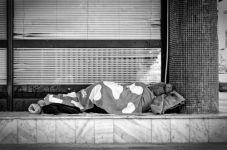Finland Is Eradicating Homelessness

Over the course of the year, politicians in Sydney and Melbourne have resorted to criminalising homelessness as a way of dealing with the increasing amount of rough sleepers turning up on city streets.
Last month, the Berejiklian government passed a bill that broadened police powers to enable them to remove people from crown lands within the City of Sydney local government area. This was in response to the Martin Place homeless camp.
In February, Melbourne city council voted to approve new bylaws to make sleeping rough on CBD streets illegal. Whether these new laws will be enacted is still up for debate.
A global crisis
Australia is currently undergoing a homelessness crisis. On any given night in this country, one in every 200 people are experiencing homelessness. Those people forced to sleep on the streets constitute about a fifth of the overall population of people with no fixed address.
The majority of European countries are facing a similar crisis. EU housing organisation FEANTSA released its second report in March this year, which found “increases in the number of homeless people… both over the short and long term” in almost all of Europe.
However, there is one exception, and that’s Finland.
Over recent years, homelessness has been on the decline in the Nordic country. Between 2008 and 2014, the number of people who were suffering long-term homelessness decreased by around 1,200 people. Rough sleeping has virtually been eradicated, along with the need for crisis accommodation.
Unconditional housing
Finland’s success is due to the widespread implementation of the housing first model. This approach initially offers homeless people permanent accommodation, along with needs-based support, rather than placing them in temporary or crisis accommodation to begin with.
The model was adopted by Finland in 2008, with the federal government, municipalities and non-government organisations working in collaboration. Those in need are offered stable accommodation with their own rental contract. And local governments provide funding for tailored support.
Digby Hughes, senior policy and research officer at Homelessness NSW, said that Australia could learn from this approach, as it shows that “homelessness can be significantly reduced,” when “affordable housing with appropriate support” is provided.
Indeed, housing first has also been shown to be more cost-effective than managing homelessness via temporary accommodation and crisis support services in the long run.
Juha Kaakinen, chief executive of the Y-Foundation, a group that offers low cost flats to homeless people in Finland, has pointed out that using the housing first model can save more than $AU 22,000 per person each year.
The Finnish approach
One of the main reasons Finland has been so successful “in addressing and eliminating homelessness… is that the government develops plans and implements them,” Mr Hughes told Sydney Criminal Lawyers®.
The homelessness expert explained that the government has applied three national strategies over the last decade. Currently, they’re into their third, which will run over the period 2016 to 2019 and has a focus on prevention.
“The target is to build or allocate 3,500 dwellings over the period for people that are homeless or at risk of becoming homeless,” Mr Hughes explained. Since 2008, “6,000 new dwellings were constructed, acquired or allocated for homeless households.”
“To date the housing retention rate is 82 percent,” he added.
Housing first in NSW
A few housing first initiatives have been implemented in Sydney. The Common Ground Project in Camperdown provides affordable accommodation and support services to 52 chronically homeless people. While Project 70 in the inner city has provided 100 people with stable accommodation.
“Both of these have had some success,” Mr Hughes continued, “but require a recognition that some of the residents will require care on a lifetime basis.”
A 2015 Homelessness NSW Registry Week report found that of the 516 homeless people that were surveyed, 29 percent reported having a brain injury. This is compared with 2.2 percent of the overall Australian population.
According to Hughes, those homeless people who reported having a brain injury will require lifetime assistance, and “there is no reason to believe that the people housed under Platform 70 or Common Ground would be a different demographic.”
Temporary is no solution
In January this year, a group of homeless people camped outside Flinders Street Station began to raise concerns amongst politicians. Similarly, the 24/7 Street Kitchen and Safe Space in Martin Place began to draw the ire of parliamentarians and councillors in May.
In both cases, politicians complained that these rough sleepers had been offered temporary accommodation by service providers, but they hadn’t accepted these offers. And this seemed to be proof that these homeless people were somehow in the wrong.
However, individuals at both sites stated that the accommodation on offer can often be inadequate and dangerous, especially for young women. RMIT homelessness professor Guy Johnson agrees. He’s explained that even when the accommodation is of better quality, it’s only a short-term solution.
The Martin Place rough sleepers were living together as a community with a sense of safety. The solution offered by government was temporary accommodation with no provision for long-term. And once this period of accommodation ran out, they’d be faced with returning to the streets alone.
What’s more, when City of Sydney council workers initially tried to close the camp down in June, a Housing NSW representative turned up and offered permanent accommodation to the people staying there. And those rough sleepers accepted the offer.
In the end, Victoria police were sent in to move on those camped at Flinders Street Station, while in Sydney, the state parliament passed legislation enabling NSW police to do the same, and those in sleeping in Martin Place took down their camp, before the troops were sent in.
An urgent change is needed
“As can be seen from the Finnish example investing in long-term housing is the answer,” Mr Hughes explained. “This is a proven strategy.” He also pointed to the need for all levels of government to implement policies to prevent people from becoming homeless in the first place.
“This involves a range of issues across portfolios, including, but not limited to, stopping exits into homelessness from corrections and hospitals, addressing veterans’ homelessness at its root source and amending the Residential Tenancy Act,” he concluded.







